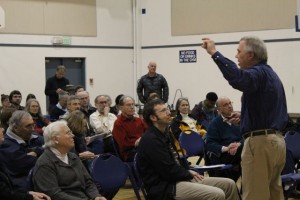
At a presentation to the Ravenna-Bryant community during the Spring General Meeting at Ravenna Eckstein Community Center, Jim Diers, former Director of the Seattle Department of Neighborhoods and author of Neighbor Power, inspired people to think more critically about neighborhood involvement and government partnerships. He offered examples of neighborhood and community projects that started with a desire to make some small change and — through a combination of shared resources and cooperation — achieved spectacular results. Beginning any enterprise is more effective when it is fun, starts on a small local level, and creates connections and networks, leading to the formation of a larger power base and alliances built to share and combine resources. This approach to community organizing was taken from lessons developed by Saul Alinsky.
Jim Diers asserted that too often governments favor the “professionalism” approach to community planning and public policy which puts greater emphasis on staff expertise while disregarding citizen input. This results in a top-down approach to community planning rather than a bottom-up approach. He argued that restricting community involvement to participation in public hearings and other established modes for formal citizen input were not usually effective in bringing about desired outcomes because these methods essentially allow community empowerment to be muffled and co-opted by the traditional power structure. He provided several examples of creative ways that communities were able to make powerful and impactful expressions of public opinion leading to positive outcomes.
Mr. Diers noted the damaging effects of an ongoing and systematic shrinking of the Seattle Department of Neighborhoods’ staff and budget and subsequent cuts to neighborhood matching funds. The declining neighborhood support in Seattle was contrasted with other governments which are able to accomplish more while conserving expenses during difficult economic times by providing additional seed money and utilizing greater neighborhood community empowerment. He pointed out the irony of other cities and regions adopting what is known as the “Seattle model” to get sustained results in hard times while Seattle seems to be abandoning it. For many who attended, the call for greater citizen involvement in community affairs struck a responsive chord.
At our upcoming general meeting in June, we would like to hear what you think about our neighborhood.
